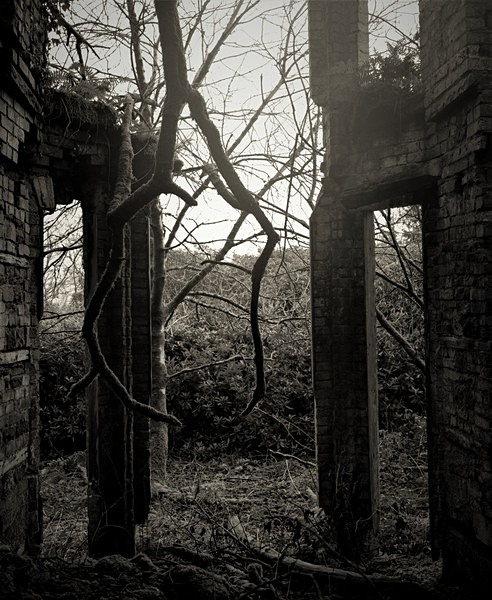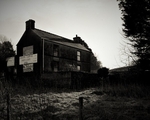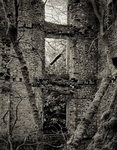CWMYGIGFRAN, Cwmdu, Carmarthenshire 2019

Notes on CWMYGIGFRAN, Cwmdu, Carmarthenshire 2019
Somehow it has been seven years since I first visited Cwmygigfran. Nothing had really changed. It is still almost totally inaccessible – due to foliage – but I do realise my camera bag and tripod do add a considerable bulk to my frame. The large trees along the pathway towards the house hints at something hidden in the mass of foliage. A low long wall is also present, almost like a low platform of a small narrow gauge railway. A small gate, open, hanging off the hinge and into a mass of tiny branches. A way through is forged. Nonetheless, it’s a real pain getting to the walls and once within the house, and climbing out a window, it does allow access to the front of the house where, strangely enough, nothing seems to grow – the rhododendrons surround the house but seem to avoid this section. The same can be said of the brambles too! So it is here, just right in front of the house the exposures need to be made. Access inside is also possible, mature trees grow inside, the walls are bare, little clue of what was once found within, that said, it is easy to see that this was once a full three storey property. Viewpoints are limited and I am aware that my first visit saw me document the better angles. I re-took an image taken from the outside and took some different internal images using a standard lens (whereas before I used a wide-angle)
Alan Richards wrote on the 'Geograph' website: A house has stood at Cwmygigfran (trans. Valley of the Raven) since circa 1600. In 1871 the house was known locally as 'The Palace' after its owner, Daniel Thomas, had spent a fortune on renovating the old place. Indeed, tradition has it that he spent so much money gentrifying the house that he couldn't afford to live there. Around the turn of the twentieth century the house began to deteriorate and by 1940 it had fallen into total disrepair. In 1960, Cwmygigfran was completely stripped of anything of value after being bought by a demolition firm from Hereford.
Once the house was photographed I then returned to the barns outside where once someone lived. Although only a few metres away, this also takes a little effort to reach. The remnants I found seven years ago seem to be less. A tarpaulin partially stops the weather but it is frayed and torn. It is an odd place. A sink but no running water, a roof but a gable end collapsed, a full height metal cupboard filled with cans of rusty nails and screws yet nothing to nail or screw down. I do not think this owner had any intention of restoring the house. It was probably beyond hope in the 1960's when the walls and roof were striped of all their worth. What chance forty years later? It is not the once rich owners I think about but the guy, I presume it was a guy, living alone, who occupied this barn. I wonder for how long? Surely not through the winter months? Was he squatting, did he own the house itself? An old Volvo estate sits not far from the house, dirty and unwanted, dead to the world. I checked to see how old the registration number is, it was built 1978-1979 - can we presume the lonesome squatter was not rich and the car was already old when he owned it, drove it up the rough track? I'm thinking late 1980's through to anytime mid-1990's. Seems reasonable but guess work nonetheless. Again, further evidence that the squatter/owner had at least lived here for a little while. It's a sad sense yet at the same time I liked it here, knowing that the house stands almost completely surrounded by impenetrable foliage, left open to the elements but once, even on a January day, the afternoon sun climbs up, it became as warm as January day can be when the bushes and trees stop the wind and the air rushing about. I certainly felt better after my visit and the walk back to the car, and indeed the drive home, felt as if my day had been worthwhile and complete.
Somehow it has been seven years since I first visited Cwmygigfran. Nothing had really changed. It is still almost totally inaccessible – due to foliage – but I do realise my camera bag and tripod do add a considerable bulk to my frame. The large trees along the pathway towards the house hints at something hidden in the mass of foliage. A low long wall is also present, almost like a low platform of a small narrow gauge railway. A small gate, open, hanging off the hinge and into a mass of tiny branches. A way through is forged. Nonetheless, it’s a real pain getting to the walls and once within the house, and climbing out a window, it does allow access to the front of the house where, strangely enough, nothing seems to grow – the rhododendrons surround the house but seem to avoid this section. The same can be said of the brambles too! So it is here, just right in front of the house the exposures need to be made. Access inside is also possible, mature trees grow inside, the walls are bare, little clue of what was once found within, that said, it is easy to see that this was once a full three storey property. Viewpoints are limited and I am aware that my first visit saw me document the better angles. I re-took an image taken from the outside and took some different internal images using a standard lens (whereas before I used a wide-angle)
Alan Richards wrote on the 'Geograph' website: A house has stood at Cwmygigfran (trans. Valley of the Raven) since circa 1600. In 1871 the house was known locally as 'The Palace' after its owner, Daniel Thomas, had spent a fortune on renovating the old place. Indeed, tradition has it that he spent so much money gentrifying the house that he couldn't afford to live there. Around the turn of the twentieth century the house began to deteriorate and by 1940 it had fallen into total disrepair. In 1960, Cwmygigfran was completely stripped of anything of value after being bought by a demolition firm from Hereford.
Once the house was photographed I then returned to the barns outside where once someone lived. Although only a few metres away, this also takes a little effort to reach. The remnants I found seven years ago seem to be less. A tarpaulin partially stops the weather but it is frayed and torn. It is an odd place. A sink but no running water, a roof but a gable end collapsed, a full height metal cupboard filled with cans of rusty nails and screws yet nothing to nail or screw down. I do not think this owner had any intention of restoring the house. It was probably beyond hope in the 1960's when the walls and roof were striped of all their worth. What chance forty years later? It is not the once rich owners I think about but the guy, I presume it was a guy, living alone, who occupied this barn. I wonder for how long? Surely not through the winter months? Was he squatting, did he own the house itself? An old Volvo estate sits not far from the house, dirty and unwanted, dead to the world. I checked to see how old the registration number is, it was built 1978-1979 - can we presume the lonesome squatter was not rich and the car was already old when he owned it, drove it up the rough track? I'm thinking late 1980's through to anytime mid-1990's. Seems reasonable but guess work nonetheless. Again, further evidence that the squatter/owner had at least lived here for a little while. It's a sad sense yet at the same time I liked it here, knowing that the house stands almost completely surrounded by impenetrable foliage, left open to the elements but once, even on a January day, the afternoon sun climbs up, it became as warm as January day can be when the bushes and trees stop the wind and the air rushing about. I certainly felt better after my visit and the walk back to the car, and indeed the drive home, felt as if my day had been worthwhile and complete.

|
